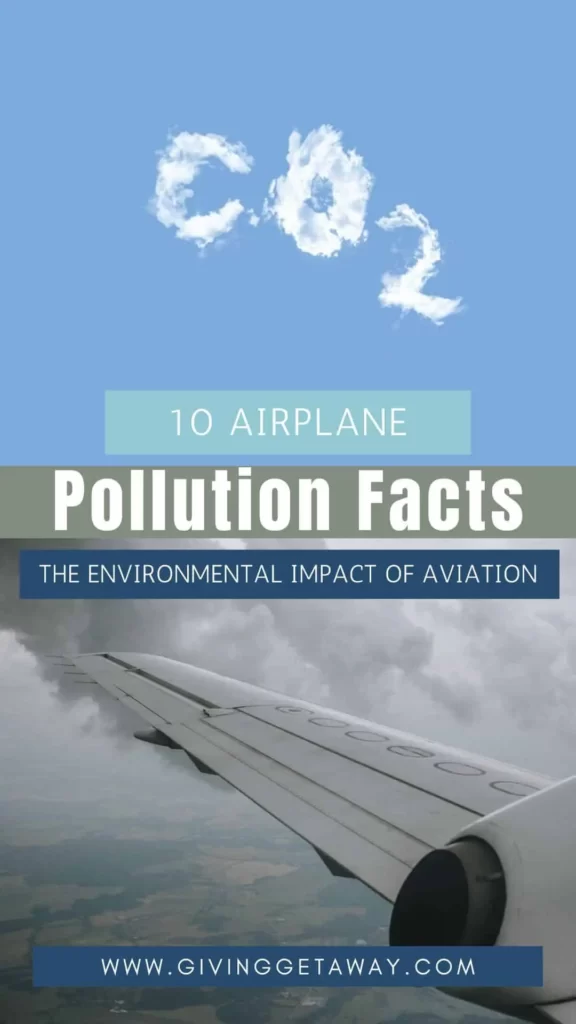| This post may contain affiliate links. Whenever you book or buy something through one of these, Giving Getaway gets a small commission, of which 100% will be donated to charity, without any extra cost to you! |
As air travel continues to be an integral part of modern life, it is crucial to understand the environmental consequences it brings. Airplanes have undoubtedly revolutionized global connectivity and accessibility, but they also leave behind a significant carbon footprint and other pollutants that affect our planet.
In this post, I will present 10 intriguing facts about airplane pollution, shedding light on its implications for the environment. From greenhouse gas emissions and contrails to ozone depletion, we’ll explore the various ways aviation impacts the Earth’s delicate ecosystem.
1) CO2 Emissions From Aviation Account For Around 3.5% Of Global CO2 Emissions
CO2 emissions from the aviation industry contribute to 2.5 to 3.5% of global CO2 emissions, highlighting its significant role in overall carbon pollution. This may seem like a small amount, but the impact of aviation on climate change is higher than its contribution to CO2 emissions alone. The industry is responsible for around 5% of global warming, including the release of other greenhouse gases, such as water vapor and nitrogen oxides, and the formation of contrails and cirrus clouds.
A return flight from London to San Francisco emits around 5.5 tonnes of CO2 equivalent (CO2e) per person, which is more than twice the emissions of an average person in a year. A single passenger traveling on a domestic flight in Britain can lead to climate impacts equivalent to 254 g of CO2 for every kilometer they travel, while a long-haul flight can release the equivalent of 102 g of CO2 for every kilometer. These figures are lower on average per kilometer because of the huge amount of emissions given off during take-off and landing.
While the aviation industry has taken steps to reduce its emissions, such as investing in more fuel-efficient aircraft and using sustainable aviation fuels, more needs to be done to achieve significant reductions in aviation emissions. However, ultimately, reducing aviation emissions is crucial in mitigating the impact of climate change.
2) Non-CO2 Effects Are Responsible for Two-Thirds of Aviation’s Climate Impact
Non-CO2 effects play a significant role in aviation’s climate impact, accounting for two-thirds of its overall contribution to climate change. These effects are responsible for twice as much global warming as aircraft CO2 emissions alone. Here are some key points to understand about the non-CO2 effects of aviation:
- Non-CO2 Effects: In addition to CO2 emissions, airplanes release other substances that have warming effects on the climate. These include nitrogen oxides (NOx), vapor trails, and cloud formation triggered by the altitude at which aircraft operate. These non-CO2 effects have a more potent warming impact than CO2 emissions.
- Climate Impact: In 2018, non-CO2 effects accounted for two-thirds of aviation’s climate impact. This means that the indirect effects of aviation, such as the formation of clouds and vapor trails, have a greater influence on global warming than the direct CO2 emissions from aircraft.
- Growing Emissions: Emissions from aviation have been increasing at a faster rate than any other mode of transport. CO2 emissions from flights within Europe alone have risen by 28% since 2013, while other sectors have managed to reduce their emissions. This highlights the need for effective measures to address aviation’s impact on climate change.
- Lack of Measures: Despite the considerable impact of non-CO2 effects, there are currently no regional or global measures in place to address these effects. This means that efforts to mitigate aviation’s climate impact have primarily focused on reducing CO2 emissions, while the indirect effects have received less attention.
3) Emissions From Aviation Are Growing Faster Than Any Other Mode of Transport
The rapid growth of emissions in the aviation sector outpaces that of any other mode of transportation. According to recent data, emissions from aviation have been increasing at an alarming rate in recent years. Between 1990 and 2019, global CO2 emissions from domestic and international flights more than doubled, with an annual growth rate of approximately 3%. This is significantly higher than the growth rates observed in other sectors such as road transport or power generation.
Several factors contribute to this rapid increase in aviation emissions. Firstly, the demand for air travel has been steadily rising due to factors like globalization and increased disposable income. As a result, there has been a significant expansion in the number of flights worldwide. Additionally, advancements in technology have made air travel more affordable and accessible, further driving up demand.
Furthermore, aircraft themselves are becoming larger and more fuel-intensive due to increased passenger capacity and longer flight distances. These developments lead to higher fuel consumption and subsequently greater CO2 emissions per flight.
4) Aviation Activities Emit Ozone and Ultrafine Particles
Aviation activities release harmful gases and particles into the atmosphere, including ozone and ultrafine particles, contributing to air quality degradation. Ozone is formed when nitrogen oxides (NOx) react with volatile organic compounds (VOCs) in the presence of sunlight. It is a potent greenhouse gas that damages vegetation and causes respiratory issues in humans. Aircraft engines emit NOx, which contributes to the formation of ozone at high altitudes where it acts as a greenhouse gas.
Ultrafine particles, also known as particulate matter (PM), are tiny solid or liquid droplets suspended in the air. They can be directly emitted from aircraft engine exhaust or form through chemical reactions between precursor pollutants such as sulfur dioxide (SO2) and nitrogen oxides. These particles have adverse effects on human health, particularly on the respiratory system.
According to studies, aviation emissions significantly contribute to global ozone levels. For instance, one study estimated that aviation activities account for about 15% of the total global anthropogenic ozone formation. Furthermore, ultrafine particles emitted by aircraft engines have been found to have negative effects on local air quality near airports.
5) Airports Can Generate Water Pollution
Airports, as bustling transportation hubs with a myriad of activities and infrastructure, can contribute to water pollution through various sources. One significant source is the de-icing process. During winter months, airports use de-icing agents to remove ice and snow from aircraft surfaces. These agents often contain harmful chemicals such as glycol-based fluids, which can contaminate nearby water bodies when they are washed away by rain or melting snow.
Additionally, airports generate stormwater runoff that can carry pollutants into nearby rivers or streams. Runoff from paved surfaces like runways and taxiways can pick up fuel residues, heavy metals from aircraft maintenance activities, and other contaminants present on the tarmac. This runoff is then discharged into the environment without proper treatment.
Airports also require extensive infrastructure for their operations. Construction activities associated with airport expansion or maintenance projects can lead to sediment runoff into nearby water bodies if proper erosion control measures are not implemented.
6) Piston Engines Used in General Aviation Burn Avgas
Piston engines commonly utilized in general aviation rely on Avgas, a type of fuel known for its combustion characteristics and compatibility with these engine types. Avgas stands for aviation gasoline and is specifically formulated to meet the unique requirements of piston-powered aircraft. It contains lead compounds, which act as an octane booster to prevent engine knocking and allow for higher compression ratios.
However, the use of Avgas in general aviation has significant environmental implications. When burned, it releases pollutants into the atmosphere, contributing to air pollution and climate change. One of the main concerns is the emission of lead, which can have detrimental effects on human health and ecosystems. Although efforts have been made to reduce or eliminate lead from other forms of gasoline, it remains a crucial component in Avgas due to its unique properties.
In addition to lead emissions, piston engines burning Avgas also produce other pollutants such as carbon monoxide (CO) and nitrogen oxides (NOx). These emissions contribute to the formation of ground-level ozone and ultrafine particles that can have adverse effects on air quality and human respiratory health.
7) Contrails and Cirrus Clouds Amplify the Warming Effect
Contrails, short for condensation trails, emerge when hot exhaust gases from airplanes mix with cold air at high altitudes. Though seemingly harmless, these wispy trails can significantly impact the Earth’s climate. Contrails often evolve into cirrus clouds, known as “aviation-induced cloudiness,” further exacerbating the warming effect of aviation emissions.
When aircraft engines release water vapor and soot particles, they create an artificial cloud, effectively trapping heat in the atmosphere. This additional cloud cover, particularly in heavily trafficked air corridors, can lead to a net increase in the Earth’s overall temperature. Scientists have been closely studying this phenomenon to better understand its implications for climate change.
8) Emissions From Flights Stay in the Atmosphere
When an aircraft burns fuel, it releases various substances into the atmosphere. These include carbon dioxide (CO2), nitrogen oxides (NOx), sulfur oxides (SOx), particulate matter (PM), and water vapor. Of these pollutants, CO2 is particularly concerning due to its role as a greenhouse gas that contributes to global warming. Additionally, NOx and SOx emissions from aircraft can lead to the formation of ozone at high altitudes and contribute to local air pollution near airports.
What sets airplane emissions apart from other sources of pollution is their potential to stay in the atmosphere for long periods. While ground-based sources may disperse more quickly or be more easily controlled through regulation, aircraft emissions have a wider geographical reach and can persist over longer distances due to their release at higher altitudes.
Understanding the impact of these emissions on climate change and air quality is crucial for developing effective strategies to mitigate their environmental consequences.
9) Airplane Pollution Contributes to the Formation of Acid Rain
The emissions released during flights have the potential to contribute to the formation of acid rain, which can have detrimental effects on ecosystems and water bodies. Acid rain is a type of precipitation that has a lower pH level than normal rainfall due to high levels of sulfur dioxide (SO2) and nitrogen oxides (NOx) in the atmosphere. These pollutants are released from aircraft engines, particularly those powered by jet fuel.
When SO2 and NOx are emitted into the atmosphere, they undergo chemical reactions with other compounds such as oxygen and water vapor. This leads to the formation of sulfuric acid (H2SO4) and nitric acid (HNO3), which can then be carried by wind currents over long distances before being deposited onto land or water surfaces through precipitation.
Deposing acid rain can have severe consequences for terrestrial and aquatic ecosystems. It can lead to soil acidification, which reduces nutrient availability for plant growth and can harm sensitive vegetation. Acid rain also affects freshwater habitats by lowering the pH levels in lakes, rivers, and streams. This increase in acidity can be harmful to fish and other aquatic organisms.
10) If Everyone in the World Took Just One Long-Haul Flight per Year…
If every individual worldwide were to partake in a single long-haul flight annually, the resultant emissions from aircraft would surpass the entirety of the CO2 emissions generated by the United States. This staggering fact underscores the significant contribution of aviation to global greenhouse gas emissions.
According to data from Transport & Environment, an environmental organization focused on sustainable transport, airplanes currently account for approximately 2.5 to 3.5% of global CO2 emissions. And according to The Guardian, even a short-haul return flight from London to Edinburgh contributes more CO2 than the mean annual emissions of a person in Uganda or Somalia.
Long-haul flights are particularly concerning because they release large amounts of carbon dioxide and other greenhouse gases directly into the upper atmosphere. These gases have a greater warming effect compared to ground-level emissions and contribute significantly to climate change. The carbon footprint of a single passenger flight hour is approximately 200 kg CO2, which is a rough estimate as many factors are unknown, such as airplane model, wind speed, and occupancy rate.
Conclusion
Airplane pollution presents significant environmental challenges, from greenhouse gas emissions impacting climate change to the amplification of warming effects through contrails and cirrus clouds.
By raising awareness and promoting conscious choices, we can contribute to a more sustainable and responsible approach to air travel, ensuring a harmonious balance between exploration and environmental preservation. So let’s work together to shape a greener and more promising future for aviation!
Now how about you? Are you ready and willing to do your part and make a difference while traveling? If so, why not use the search widgets or click on the ad banners on this website to book your accommodations, flights, rental cars, and more?
Your completed booking will earn a commission, with 50% of the profits going towards charity events like the 2021 Christmas gift drive for kids and teens in a children’s home in Montenegro.
So not only will you be enjoying a wonderful vacation, but you’ll also be contributing to a better world. Book your trip through our site and join us in making a positive impact today!


























Your article is very telling. Why are so many of us disregarding the climate impacts of our increasing air travel? What is one thing we can do to lessen the effects of it? For example: Are you prepared to travel less? Do you purchase carbon offsets? What do know about whether they work?